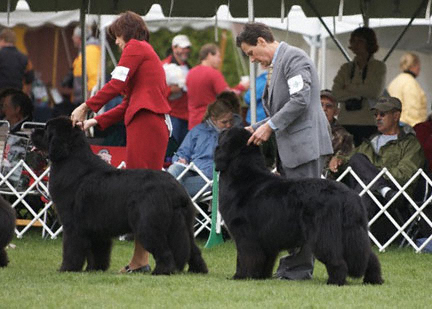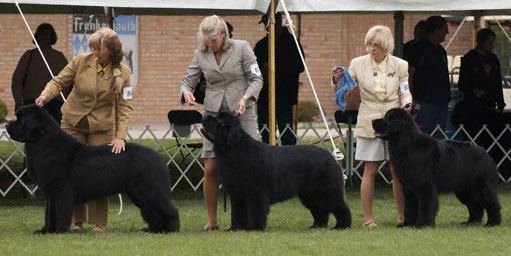Grooming Techniques for the Show Newfoundland by Jo Anne Nussle
 Grooming your Newfoundland should be a rewarding experience for both you and your dog. Starting at puppy-hood, you should get your dog used to being on a grooming table; this will save your back in years to come. A grooming arm on your table will add safety and precision in your trimming and help keep your dog from moving too much.
Grooming your Newfoundland should be a rewarding experience for both you and your dog. Starting at puppy-hood, you should get your dog used to being on a grooming table; this will save your back in years to come. A grooming arm on your table will add safety and precision in your trimming and help keep your dog from moving too much.
Your tools are a key to quality grooming; as in any job you must have the proper tools to do the job well. The following is a list of what I find necessary to groom my Newfoundlands: pin brush, greyhound comb, mat breaker, heavy duty rake, slicker brush, and straight, curved and thinning shears. The cost and quality of shears can really vary. Find shears that feel good in your hand and that are appropriate for your budget. The number of dogs that you're regularly trimming may also affect your choice of equipment.
Bathing your dog is one of the first steps to take when getting the dog ready for a show ring appearance. Make sure your dog is totally combed out before applying any water to the coat; this also means combing before going for a swim! If you have any mats in the coat, you will want to remove them before applying any water, as they will only get tighter when wet. You want to comb the coat from the skin out. This will allow for air to get to the skin and will bring out the natural oils in the coat. The more combing and brushing you do, the more you stimulate the hair follicles.
 When bathing your Newfoundland, always use a good quality dog shampoo. These can be purchased at dog shows or in dog supply catalogs. I like to use a concentrated shampoo that I dilute appropriately. After you have your dog all lathered up, take a little extra time to give a good body massage. This makes for a good experience for the dog in getting a bath. Be sure to rinse the coat thoroughly, as any shampoo left in the coat can cause flaking and other problems. Following the bath, dry your potential show dog with a blow dryer. The more powerful ones shorten the time required! It is best to comb the dog in the direction the coat lays the entire time the drying process is occurring. This can help train the coat to lie flatter and eliminates dryer mats.
When bathing your Newfoundland, always use a good quality dog shampoo. These can be purchased at dog shows or in dog supply catalogs. I like to use a concentrated shampoo that I dilute appropriately. After you have your dog all lathered up, take a little extra time to give a good body massage. This makes for a good experience for the dog in getting a bath. Be sure to rinse the coat thoroughly, as any shampoo left in the coat can cause flaking and other problems. Following the bath, dry your potential show dog with a blow dryer. The more powerful ones shorten the time required! It is best to comb the dog in the direction the coat lays the entire time the drying process is occurring. This can help train the coat to lie flatter and eliminates dryer mats.
Trimming your Newfoundland should be done for the neatness the Standard calls for. Some dogs require more than others. If your dog has excessive hair on top of its head, you will want to use your thinning shears to shorten it up. When trimming the ears, you should start by trimming off any excess hair hanging below the flap of the ear. Then follow up the leather of the ear with your thinning shears to make the ears appear neat. Lift the ear and trim the excess hair under the ear to allow for more airflow to the ear.
In trimming the feet, always have your Newfoundland stand. Using straight scissors, trim the hair between the pads flush to the pads. Be careful not to trim too far up on the back pads as this can create a hole when you place the foot back down on the table. After trimming the bottom of the foot, lay it back down on the table and trim excessive hair on the sides of the foot with straight or curved scissors to round our the foot. You are looking for a well-rounded foot, like a cat's paw, for the end product. To achieve this, brush the hair up between the roes with your slicker brush and trim off excess hair with your thinning shears. You do not want to cut the hair so short that you define each toe. Trim the hocks with thinning shears if the hair is excessively long. The final length should be between one to two inches.
Trimming the body coat on a Newfoundland has caused a lot of controversy among fanciers. You want your dog to appear neat. Most Newfoundlands grow excessive hair around the neck. This can cause an appearance of having a short neck. Using your thinning shears work from under the ear down into the bib, shortening the hair for your desired look. Do not cut above the ears on the neck. Working in from of a mirror can help you achieve your desired look. Some Newfoundlands, especially puppies, grow lots of hair at the top of the elbows. This can make the dog appear out at the elbow. To eliminate this you might want to use thinning shears and blend the excess into the leg. Never cut across the coat. Always use your scissors in the direction the hair lays.
Remember grooming your Newfoundland should be a rewarding experience for both of you! Also, practice helps improve your skills. Remember, the hair will always grow back! Most of all ENJOY.
reprinted from NewfTide 2002, Images © Chad Perry 2009, used with permission